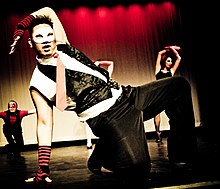Vogue (dance)
Vogue or Voguing refers to a dance style that emerged in the ballroom scene of the marginalized homosexual subculture of New York Harlem in the early 1980s . The dance style developed through its typically strictly linear and right-angled arm and leg movements based on the poses and postures of models. The name comes from the fashion magazine of the same name, Vogue .
to form
The basis of the movement is the conscious step on the catwalk , which is characterized by pronounced hip swing and the crossing of the balls of the feet when touching down on an absolutely straight line. Each step is emphasized individually and supported with the shoulders. Based on this, movements are built in, each ending in poses that are held for brief moments . Originally, inspiration for these poses was taken from martial arts films, hip-hop, rhythmic gymnastics, and some dancers claimed to recreate Egyptian hieroglyphs with their bodies. In the end, typical poses from fashion photography prevailed: every movement marks a photo, a sequence of movements a series of photos. Lines and angles are precisely studied and executed.
development
In the early 1980s, it was expanded and individualized to include African American and Latin American homosexuals.
The dance was founded in 1989 by the single release Deep in Vogue by Malcolm McLaren , the song Vogue by Madonna in 1990 and the documentary Paris Is Burning by Jenny Livingston also popular in the international majority audience.
An important social place of Vogue dance since its inception have been competitions that are held between associations formed like families, the houses . The Houses often have brand names or designations from the fashion world, such as the House of Dior, the House of Escada, the House of LaBeija or the House of Xtravaganza.
"Vogue is a bit superficial because you are judged by your appearance," said dancer and dance teacher Archie Burnett in 2014. "But if you have nothing else, no work, no money, and you mean nothing to society - you fake it to make it. "
The voguing dance style has made it to German stages through the works of the American director Trajal Harrell .
literature
- Chantal Regnault: Voguing. Voguing and the House Ballroom Scene of New York City 1989-92 . Soul Jazz Books, London 2011
Individual evidence
- ↑ a b c taz: Fake it to make it! , August 14, 2014
- ↑ Judith Mackrell: Trajal Harrell - the dirtydancer Voguing his way into history. The Guardian, August 1, 2017, accessed December 12, 2019 .
- ↑ Big stage: Highlights Trajal Harrell: Juliet & Romeo. Retrieved December 12, 2019 .
